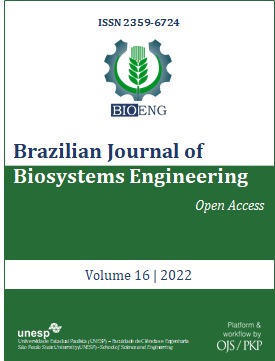Cucumber seedlings production: tray size impact on development
DOI:
https://doi.org/10.18011/bioeng.2022.v16.1079Keywords:
Cucumis sativus, Morphological Development, Seedling QualityAbstract
The size of the tray in seedling production has a direct influence on the area of root development and availability of resources, such as water as well as nutrients, with a potential impact on the seedling final quality. The objective of this work was to analyse the impact of the tray size on the development of cucumber seedlings. As such, this study was developed in two experiments: in the first, seedlings produced in trays with 50 and 128 cells were compared, while in the second, trays with 50, 98, and 128 cells were considered. For that, polyethylene trays and commercial substrate were used. The trays were kept in a greenhouse, and evaluations were carried out at 21 days after sowing. Morphological development and SPAD index were analysed. The data were submitted to ANOVA and the means compared by the Tukey test (0.05). Linear correlation was performed between the analysed variables. The best development of cucumber seedlings was obtained by adopting trays with 50 cells. Cucumber seedlings produced in trays with a higher number of cells show reduced development, mass accumulation and lower photosynthetic activity.
Downloads
References
Aslam, W., Noor, R.S., Hussain, F., Ameen, M., Ullah, S., & Chen, H. (2020). Evaluating Morphological Growth, Yield, and Postharvest Fruit Quality of Cucumber (Cucumis Sativus L.) Grafted on Cucurbitaceous Rootstocks. Agriculture, 10 (4), e101. https://doi.org/10.3390/agriculture10040101.
Bayoumi, Y.A., El-Henawy, A., Abdelaal, K.A.A., & Elhawat, N. (2019). Grape Fruit Waste Compost as a Nursery Substrate Ingredient for High-Quality Cucumber (Cucumis sativus L.) Seedlings Production. Compost Science & Utilization, 27 (4), 205-216.https://doi.org/10.1080/1065657X.2019.1682086.
Cavalcanti, S.D.L., Gomes, N.F., Pandorfi, H., Almeida, G.L.P., & Montenegro, A.A.A. (2019). Variação espaço-temporal da temperatura do substrato em bandejas de produção de mudas. Revista de Agricultura Neotropical, 6 (1), 66-73. https://doi.org/10.32404/rean.v6i1.2648.
Fan, H.F., Ding, L., Xu, Y.L., & Du, C.X. (2017). Antioxidant system and photosynthetic characteristics responses to short-term PEG-induced drought stress in cucumber seedling leaves. Russian Journal of Plant Physiology, 64, 162-173. https://doi.org/10.1134/S1021443717020042.
Feng, S., Zhang, J., Um, Z., Wen, C., Wu, T., Li, Z., & Wang, H. (2020). Recent progress on the molecular breeding of Cucumis sativus L. in China. Theoretical and Applied Genetics, 133, 1777-1790. https://doi.org/10.1007/s00122-019-03484-0.
Ferreira, D.F. (2019). SISVAR: a computer analysis system to fixed effects Split plot type designs. Revista Brasileira de Biometria, 37 (4), 529-535. https://doi.org/10.28951/rbb.v37i4.450.
Gao, D., Zhou, X., Duan, Y., Fu, X., & Wu, F. (2017). Wheat cover crop promoted cucumber seedling growth through regulating soil nutrient resources or soil microbial communities? Plant and Soil, 418, 459-475. https://doi.org/10.1007/s11104-017-3307-9.
Garcia, C., & Lopez, R.G. (2020). Supplemental Radiation Quality Influences Cucumber, Tomato, and Pepper Transplant Growth and Development. HortScience, 55 (6), 804-811. https://doi.org/10.21273/HORTSCI14820-20.
Hassan, S.M., Ashour, M., Sakai, N., Zhang, L., Hassanien, H.A., Gaber, A., & Ammar, G. (2021). Impact of Seaweed Liquid Extract Biostimulant on Growth, Yield, and Chemical Composition of Cucumber (Cucumis sativus). Agriculture, 11 (4), e320. https://doi.org/10.3390/agriculture11040320.
Kumi, F., Korkpoe, F., & Osei, G. (2020). influence of plug cell volume and substrate type on the development of cucumber seedlings for transplanting. International Journal of Technology and Management Research, 4 (1), 50 – 64. https://doi.org/10.47127/ijtmr.v4i1.76.
Ma, G., Mao, H., Bu, Q., Han, L., Shabbir, A., & Gao, F. (2020). Effect of Compound Biochar Substrate on the Root Growth of Cucumber Plug Seedlings. Agronomy, 18 (8), e1080. https://doi.org/10.3390/agronomy10081080.
Song, J., Cao, K., Hao, Y., Song, S., Su, W., & Liu, H. (2019). Hypocotyl elongation is regulated by supplemental blue and red light incucumber seedling. Gene, 707, 117-125. https://doi.org/10.1016/j.gene.2019.04.070.
Watthier, M., Schwengber, J.E., Fonseca, F.D., & Silva, M.A.S. (2019). Húmus de minhoca e casca de arroz carbonizada como substratos para produção de mudas de alface. Brazilian Applied Science Review, 3 (5), 2065-2071. https://doi.org/10.34115/basrv3n5-011.
Wenneck, G.S., Saath, R., Rezende, R., Santi, D.C., Andrean, A.F.B., Araújo, L.L., & Sá, N.O. (2021). Development of cauliflower seedlings due to the increase of silicon in substrate. Colloquium Agrariae, 17 (1), 18-24. https://doi.org/10.5747/ca.2021.v17.n1.a416.
Downloads
Published
How to Cite
Issue
Section
License
Copyright (c) 2022 The Authors

This work is licensed under a Creative Commons Attribution 4.0 International License.
By publishing in this journal, authors agree to the following terms:
a) Authors retain copyright and grant the journal the right of first publication. The work is simultaneously licensed under the Creative Commons Attribution License, which permits sharing and adaptation of the work with appropriate credit to the authors and the journal.
b) Authors may enter into separate, additional agreements for non-exclusive distribution of the published version of the work (e.g., posting to an institutional repository or inclusion in a book), provided that proper credit is given to the original publication in this journal.










